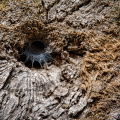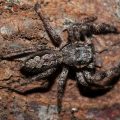The barking spider tarantula is easy to care for arachnid that is pretty set in its ways and prefers to busy itself with climbing and burrowing. Set up a terrarium factoring in the conditions the spider would actually be in if it were in its natural environment.
It would be important to recreate temperature conditions its body is acclimated to in order for it to thrive best. Choosing the right substrate also helps in actualizing the spiders natural environment and its innate trait of burrowing underground. Provide the fresh water for it to drink and to help the enclosures humidity needs.
Moss peat is a good choice of substrate because it is sans fertilizers. Be sure to sterilize the substrate to rid it of mites which may be present in the substrate and which can subsequently attack the spider.
The size of the enclosure should neither be too big nor too large. The actual height of the interior is variable depending on the species. You can opt to purchase clear, plastic containers because they are inexpensive, and they allow you to see clearly inside and observe your barking spiders and the interior of the cage to check that everything is clean and in good order. Or you can also buy a small glass vivarium if that’s what you prefer.
Equip the tank or terrarium with sufficient substrate at least 3 – 4 inches so that your barking spider can have something to burrow. The larger the spider, the deeper should the substrate be. You can also provide your pet with places to climb inside the cage such as a plastic plant or a tree bark. Just make sure to not put many elevated structures within the enclosure because your pet could escape.
Habitat Materials for Your Barking Spider
Aside from moss peat, you can also choose sterilized potting soil, crushed coconut fiber, horticultural vermiculite, for substrate. Just make sure that it is pesticide and fertilizer free. Keep the substrate moist, but do not saturate it with water; you can do this by keeping the bottom depth of the substrate damp, while the upper portion dry except for perhaps a slightly damp corner.
Make sure to also put plants, rocks, logs, or tree barks and provide specific lightning. Keep in mind that barking spiders and spiders in general, do not like bright lights. In fact, lighting can actually dry out the cage’s interior. If you do want light, select a low-wattage fixture with a red light. Locate the enclosure in place where it will not be under direct sunlight and is free from drafts. Make sure that they will not be disturbed by your other household pets such as dogs and cats.






 Author and long-time animal lover. Sharing knowledge on pet care through experience and the written word.
Author and long-time animal lover. Sharing knowledge on pet care through experience and the written word.